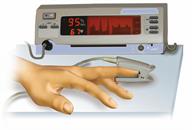ThisisPatientEngagementcontent
O que acontece quando o paciente vai para casa?
Saiba mais sobre nossos produtos de Patient Engagement agora! Transforme seus pacientes em participantes ativos em seus cuidados de saúde, dando a eles acesso fácil às mesmas informações baseadas em evidências em que você confia - mas fornecidas em um formato fácil de entender.

Pulse oximetry is a way to measure the oxygen level in your blood without a blood test. It uses a sensor called a pulse oximeter. It also tracks your heart rate.
A pulse oximeter can show you:Your health care provider will talk with you about risks. You may get skin sores if the sensor is left in the same spot for too long. But this is rare.
If a more accurate result is needed, you may have a blood test done.
This information is not intended to replace advice given to you by your health care provider. Make sure you discuss any questions you have with your health care provider.
Cookies são usados neste site. Para recusar ou saber mais, visite nosso conheça nosso aviso de cookies.
Copyright © 2025 Elsevier, its licensors, and contributors. All rights are reserved, including those for text and data mining, AI training, and similar technologies.